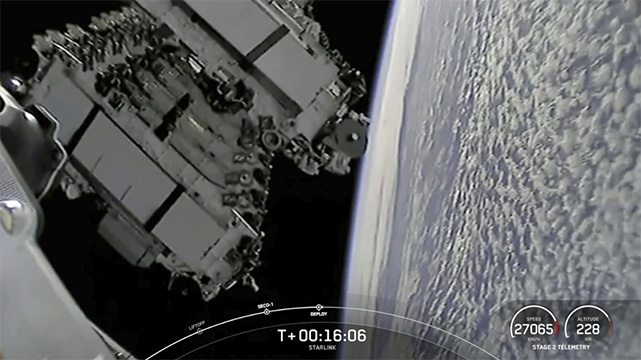
In this image from video provided by SpaceX, a Falcon 9 deploys Starlink satellites after it lifted off from Cape Canaveral, Fla., Space Force Station on Saturday, Nov. 13, 2021.
Photo: SpaceX via AP
Stealth submarines fitted with space-shooting lasers and custom-built attack satellites armed with ion thrusters. Those are just some of the strategies Chinese scientists have been developing to counter what Beijing sees as a potent threat: Elon Musk’ s armada of Starlink communications satellites.
Chinese government and military scientists, concerned about Starlink’s potential use by adversaries in a military confrontation and for spying, have published dozens of papers in public journals that explore ways to hunt and destroy Musk’s satellites, an Associated Press review found.
Chinese researchers believe that Starlink — a vast constellation of low-orbit satellites that deliver cheap, fast and ubiquitous connectivity even in remote areas — poses a high risk to the Chinese government and its strategic interests. That fear has mostly been driven by the company’s close ties to the U.S. intelligence and defense establishment, as well as its growing global footprint.
“As the United States integrates Starlink technology into military space assets to gain a strategic advantage over its adversaries, other countries increasingly perceive Starlink as a security threat in nuclear, space, and cyber domains,” wrote professors from China’s National University of Defense.
Musk pumped tens of millions of dollars into President Donald Trump’s reelection effort and emerged, temporarily, as a key adviser and government official. As Musk toys with the idea of starting his own political party, he has also taken an increasing interest in European politics, using his influence to promote an array of hard-right and insurgent figures often at odds with establishment politicians.
Musk left the Trump administration in May and within days his relationship with Trump publicly imploded in a feud on social media. SpaceX, the rocket launch and space-based communications company that Musk founded and that operates Starlink, remains inextricably linked with core U.S. government functions. It has won billions in contracts to provide launch services for NASA missions and military satellites, recuperate astronauts stranded at the International Space Station and build a network of spy satellites for the National Reconnaissance Office.
Starlink’s space dominance has sparked a global scramble to come up with viable alternatives. But its crushing first-mover advantage has given SpaceX near monopoly power, further complicating the currents of business, politics and national security that converge on Musk and his companies.
Since its first launches in 2019, Starlink has come to account for about two-thirds of all active satellites, according to Jonathan McDowell, an astronomer at the Harvard-Smithsonian Center for Astrophysics, who writes a newsletter tracking satellite launches. SpaceX operates more than 8,000 active satellites and eventually aims to deploy tens of thousands more.
Beijing’s tendency to view Starlink as tool of U.S. military power has sharpened its efforts to develop countermeasures — which, if deployed, could increase the risk of collateral damage to other customers as SpaceX expands its global footprint. The same satellites that pass over China also potentially serve Europe, Ukraine, the United States and other geographies as they continue their path around the earth.
Starlink says it operates in more than 140 countries, and recently made inroads in Vietnam, Niger, Somalia, the Democratic Republic of Congo and Pakistan. In June, Starlink also obtained a license to operate in India, overcoming national security concerns and powerful domestic telecom interests to crack open a tech-savvy market of nearly 1.5 billion people.
On the company’s own map of coverage, it has very few dead zones beyond those in North Korea, Iran and China.
Though Starlink does not operate in China, Musk’s satellites nonetheless can sweep over Chinese territory. Researchers from China’s National Defense University in 2023 simulated Starlink’s coverage of key geographies, including Beijing, Taiwan, and the polar regions, and determined that Starlink can achieve round-the-clock coverage of Beijing.
“The Starlink constellation coverage capacity of all regions in the world is improving steadily and in high speed,” they concluded.
Chinese academics have encouraged Beijing to use global regulations and diplomacy to contain Musk, even as the nation’s engineers have continued to elaborate active countermeasures: Deploy small optical telescopes already in commercial production to monitor Starlink arrays. Concoct deep fakes to create fictitious targets. Shoot powerful lasers to burn Musk’s equipment.
Some U.S. analysts say Beijing’s fears may be overblown, but such assessments appear to have done little to cool domestic debate. One Chinese paper was titled, simply: “Watch out for that Starlink.”
read more in our Telegram-channel https://t.me/The_International_Affairs

 11:21 06.08.2025 •
11:21 06.08.2025 •






















